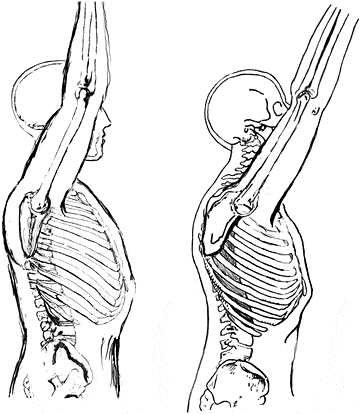Do you get medial (inside) elbow pain when you’re pressing weights overhead? Or maybe when you’re doing a pull-down motion?
This could be your solution.
First, the (relatively) simple explanation:
Why does your elbow hurt when you’re pressing (or pulling) weights overhead?
The thing that we see most commonly in folks complaining of elbow discomfort with overhead exercise is a relatively flat thoracic spine (upper back).

I think that somewhere along the way, we (collectively) were encouraged to think that slouching is bad and thus, standing upright and tall (which requires straightening out through your upper back) was therefore, good. Or at least better.
And/or, for our circus friends (or anyone who does lots of overhead sports-ing), all of that overhead reaching can often lead to a straightening of the upper back.
Ideally, the thoracic spine has a bit of a curve. Normally, this works well because the shoulder blades—which sit and move upon the thoracic spine—are not flat.
The shoulder blades are concave (curved) and they function best when they have a convex (curved) surface on which to do their thing.
(The shoulder blade’s ‘thing’, by the way, is basically moving and positioning the ‘socket’ under the ‘ball’ of the humerus).

When you are able to maintain a degree of upper back curvature while you are pushing or pulling overhead, your shoulder blades are able to position themselves optimally. This means your upper arm bone will be able to rotate the way it needs to.
[Brief nerdy interjection: strictly speaking, what we’re looking for here also includes a degree of posterior expansion of your ribcage as part of functional breathing mechanics. So, thoracic curve, yes. But also ribcage expansion. Both serve to create that nice convex surface for the concave shoulder blade.]
On the other hand, when the upper back ends up in a flat position, it tends to make the movement and positioning of your shoulder blades less than optimal.
Your shoulder’s range of motion ends up subtly limited. Specifically, the limitation tends to manifest as the limited ability of the upper arm bone to rotate within the socket (which is on the shoulder blade).
In order to perform a given overhead pulling (or pressing) exercise, your shoulder needs to do two things:
- move through the required range of motion; and
- produce force (be strong) through that range of motion.
If your upper arm bone can’t rotate the way it needs to and (this is the critical bit) you’re holding onto a bar (which fixes the relative position of your lower arm bones), your elbow gets caught in the middle and this translates into strain on your elbow.
This could be your simple solution for medial elbow pain
First, (phase one, if you will) get the feel for posterior expansion.
And then, feel and train posterior expansion as the starting point for horizontal reaching movements, like rows and presses.
As you progress, I recommend adding some crawling:
And then (phase two), feel—and train—posterior expansion as the starting point for not-quite overhead reaching movements. We’re fond of angled presses (sometimes known as landmines) and angled pulldowns:
You may have noticed that all of the demo videos feature band exercises (which can be extended to include exercises using cable machines). This is because they provide greater freedom for relative rotation of the forearm. As noted above, using a fixed hand position–as you would in an angled barbell press, for example–is more likely to be bothersome if your current range of motion is somewhat limited.
Note about going fully overhead:
The final phase–if you’ve been playing along at home–is to integrate this idea of posterior expansion of your ribcage into fully overhead movements.
When posterior expansion is new to you, this can be tricky at first (which is why I outlined the progression above). Those upper back muscles of yours are just so accustomed to pushing your ribcage forward. The further overhead your arms go, the harder it’s going to be to establish a good starting point for your ribcage. As with most things, practice makes it easier over time.
That said, if it hurts, maybe take a break from fully-overhead pulling or pressing while you teach your body to move in a new way. Oh, and if it doesn’t get better after a week or two, this is where your friendly neighborhood physical therapist can help you.

